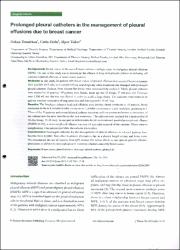| dc.contributor.author | Demirhan, Özkan | |
| dc.contributor.author | Ordu, Çetin | |
| dc.contributor.author | Toker, Alper | |
| dc.date.accessioned | 2014-11-13T14:38:19Z | |
| dc.date.available | 2014-11-13T14:38:19Z | |
| dc.date.issued | 2014 | |
| dc.identifier.citation | Demirhan O, Ordu C, Toker A. Prolonged pleural catheters in the management of pleural effusions due to breast cancer. Journal of Thoracic Disease. 2014; 6(2): 74-78. doi: 10.3978/j.issn.2072-1439.2013.12.38. | en_US |
| dc.identifier.issn | 2072-1439 | |
| dc.identifier.uri | http://www.ncbi.nlm.nih.gov/pmc/articles/PMC3944175/pdf/jtd-06-02-074.pdf | en_US |
| dc.identifier.uri | https://hdl.handle.net/11446/541 | en_US |
| dc.description | İstanbul Bilim Üniversitesi, Tıp Fakültesi. | en_US |
| dc.description.abstract | Background: Breast cancer is the second most common etiologic cause in malignant pleural effusions (MPE). The aim of this study was to investigate the efficacy of long term pleural catheters in inducing self sclerosis in pleural effusions of breast cancer patients.
Methods: In this study, 26 patients with breast cancer relapleural effusions that occurred between January 2011 and July 2013, who were considered not to undergo any other treatments and managed with prolonged pleural catheters (Jackson-Pratt silicone flat drain), were retrospectively analyzed. Thirty pleural catheters were inserted in 26 patients. All patients were female, mean age was 52 (range, 37-66) years old. Drainage over 1,500 mL per day was not allowed in order to avoid a lung edema. The catheters were removed in patients who had restoration of lung expansion and drainage under 50 mL/day.
Results: The histologic subtypes in pleural effusions were invasive ductal carcinoma in 18 patients, ductal carcinoma in situ in 4, invasive lobular carcinoma in 2, tubular carcinoma in 1, and medullary carcinoma in 1. Three of the 26 patients underwent bilateral catheter insertion, and one patient underwent a reinsertion of the catheter into the same hemithorax due to a recurrence. The catheters were retained for a mean period of 18 days (range, 11-38 days). In one patient with invasive ductal carcinoma and paramalignant pleural effusion (PMPE) (3.8%), a recurrent pleural effusion was seen 34 days after removal of the catheter. There were no complications. One patient died while the catheter was in place.
Conclusions: Prolonged catheters for the management of pleural effusions in selected patients have become more popular than other treatment alternatives due to a shorter length of stay and lower costs. We recommend the use of Jackson Pratt (JP) silicone flat drains which in our opinion provide effective pleurodesis in addition to easy application in recurrent effusions caused by breast cancer. | en_US |
| dc.language.iso | eng | en_US |
| dc.publisher | Pioneer Bioscience Publ. Co. | en_US |
| dc.rights | info:eu-repo/semantics/openAccess | en_US |
| dc.subject | breast cancer | en_US |
| dc.subject | pleural effusion | en_US |
| dc.subject | prolonged pleural catheter | en_US |
| dc.subject | pleurodesis | en_US |
| dc.title | Prolonged pleural catheters in the management of pleural effusions due to breast cancer | en_US |
| dc.type | article | en_US |
| dc.relation.journal | Journal of Thoracic Disease | en_US |
| dc.department | DBÜ, Tıp Fakültesi | en_US |
| dc.identifier.issue | 2 | |
| dc.identifier.volume | 6 | |
| dc.identifier.startpage | 74 | |
| dc.identifier.endpage | 78 | |
| dc.contributor.authorID | TR40362 | en_US |
| dc.contributor.authorID | TR42372 | en_US |
| dc.contributor.authorID | TR175564 | en_US |
| dc.relation.publicationcategory | Belirsiz | en_US |


















